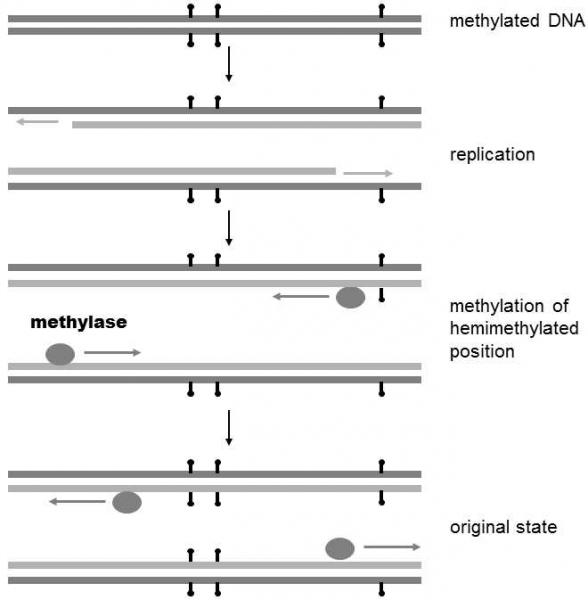II.8.1 Epigenetic information plays a major role in body formation in multicellular organisms.
Epigenetic changes also include modification of the DNA and proteins bound to it through methylation, acylation or bonding through other reaction groups based on nucleic acids or on the aminoacids of chromosome proteins. Some of these changes are also transferred to further cellular generations. For example, cells may contain specialized enzymes that search for places in the DNA where one of the chains is methylated. They then methylate the second chain from these hemimethylated sites. If replication occurs in a certain DNA section, then these enzymes methylate the newly synthesized chain and thus renew the relevant methylation signal (Fig. II.18). Methylation of the regulation areas of some DNA sections can negatively or positively affect their transcription and the relevant regulation changes are transferred to further generations in the given cellular line.

Fig. II.18 Transfer of epigenetic information. Part of the epigenetic information is stored in the form of methyl groups covalently bonded to specific positions, especially the regulation sections of the DNA. The presence of methylated bases in approximately opposite positions in the DNA chain affects the intensity of translation of the relevant genes and thus also the phenotype of the particular cell and the particular organism. If replication occurs in the given DNA section, the methyl group will always contain only one of the two strands of the new DNA double helix. However, the synthesis of specialized methylases can be initiated in the cell, which seek out the hemimethylated positions and methylate the other chain there. This mechanism can very reliably transfer epigenetic information from one generation to the next, both in the somatic cells and, in some cases, in the germinal line.
ce permitted the formation of complicated multicellular organisms (Jablonka & Lamb 1995).Functional and morphological differentiation of the individual cellular lines is of fundamental importance in formation of the bodies of multi-cellular organisms. The individual animal and plant tissues consist of specialized cells, where division of these cells or their more or less specialized precursors again yields the specialized cells of the relevant tissues. It is highly probable that most differentiation changes occur through covalent and noncovalent modifications of regulation areas of the individual components of chromatin. Obviously, other cellular structures can also become the carriers of epigenetic information. Especially the receptor apparatus of the external cell membrane decides to a substantial degree which signals the given cell can receive and to which it can react. Synthesis of receptors, which enable receiving of the given signal, can also be part of the response to a particular signal. This means that the relevant differentiated state of the cells of a certain line is spontaneously maintained over time without requiring any modification of the actual cellular DNA. According to some authors, the formation of specialized mechanisms of epigenetic inheritance.
